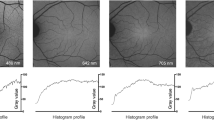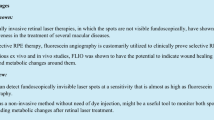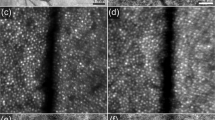Abstract
Background
Fundus autofluorescence (AF) is derived from the lipofuscin contained by the retinal pigment epithelial cells. Using a scanning laser ophthalmoscope, two-dimensional AF measurements of the ocular fundus can be achieved. Directly after conventional photocoagulation and also after selective RPE laser treatment (SRT) with ophthalmoscopically non-visible laser lesions, irradiated areas reveal reduced AF, indicating RPE damage. Since the green treatment laser beam could also be used for AF excitation, the aim of this study was to evaluate whether absolute measurements of AF can be performed, and also possible changes in AF detected, online during SRT.
Methods
SRT was carried out by use of a frequency-doubled Nd:YLF laser (wavelength 527 nm, pulse duration 1.7 µs, repetition rate 500 and 100 Hz, number of pulses 100 and 30, single pulse energy 50–130 µJ) in vitro (porcine RPE; retinal spot size 160 µm) and during patient treatment (retinal spot size 176 µm). During irradiation, fluorescence light from the RPE was decoupled from the laser light inside the slit lamp and detected by a photomultiplier or photodiode at wavelengths above 550 nm. Additionally, temperature-dependent fluorescence intensity measurements of A2-E, the main fluorescent component of lipofuscin, were performed in a different in-vitro setup.
Results
The intensity of AF decreased over the number of applied pulses during laser irradiation, and this trend was more pronounced in porcine RPE samples than during human treatment. In vitro, the AF intensity decreased by about 22%; however, only a weak signal was detected. When treating patients, the AF intensity was strong and the rate of decay of fluorescence intensity with number of pulses was greater when irradiating at 500 Hz than at the 100 Hz repetition rate. However, for both repetition rates the AF decay was merely up to 6–8% over the number of pulses per laser spot. Fluorescence intensity of A2-E decreased linearly with increasing temperature at about 1% per 1°C and was completely reversible.
Conclusions
Online measurements of AF during selective RPE laser treatment are possible and reveal a decay in AF as a function of the number of laser pulses applied to the RPE. If A2-E results can be transferred to RPE fluorescence, the AF decay could be related to the temperature increase within the tissue during treatment. Further clinical studies—in SRT as well as in conventional laser photocoagulation—might be able to show online AF changes on different areas of the retina and on different pathologies. Due to the temperature dependence of the fluorescence, on-line AF measurements during laser treatments such as photocoagulation or TTT may be able to be used as a real-time method for temperature monitoring.






Similar content being viewed by others
References
Brinkmann R, Hüttmann G, Rögener J, Roider J, Birngruber R, Lin CP (2000) Origin of retinal pigment epithelium cell damage by pulsed laser irradiance in the nanosecond to microsecond time regimen. Lasers Surg Med 27:451–464
Delori F (1994) Spectrophotometer for noninvasive measurement of intrinsic fluorescence and reflectance of the ocular fundus, Appl Phys 33:7439–7452
Delori FC, Dorey K, Staurenghi G, Arend O, Goger DG, Weiter JJ (1995) In vivo autofluorescence of the ocular fundus exibits retinal pigment epithelial lipofuscin characteristics. Invest Ophthalmol Vis Sci 36:718–729
Del Priore LV, Glaser BM, Quigley HA, Green R (1989) Response of pig retinal pigment epithelium to laser photocoagulation in organ culture. Arch Ophthalmol 107: 119–122
Eldred GE (1993) Age pigments structure. Nature 364:396
Eldred GE, Lasky MR (1993) Retinal age-pigments generated by self-assembling lysosomotropic detergents. Nature 361:145–152
Framme C, Roider J (2004) Immediate and long-term changes of retinal continuous-wave laser lesions in fundus autofluorescence. Ophthalmic Surg Lasers (in press)
Framme C, Schuele G, Birngruber R, Brinkmann R, Roider J (2002) Autofluorescence imaging after selective RPE laser treatment in macular diseases and clinical outcome: a pilot study. Br J Ophthalmol 86 (10): 1099–1106
Gabel VP, Birngruber R, Hillenkamp F (1978) Visible and near infrared light absorption in pigment epithelium and choroid. In: Shimizu K (ed) International Congress Series No. 450, XXIII Concilium Ophthalmologicum, Kyoto. Excerpta Medica, Princeton, NJ, pp 658–662
Holz FG, Schutt F, Kopitz J, Eldred GE, Kruse FE, Volcker HE, Cantz M (1999) Inhibition of lysosomal degradative functions in RPE cells by a retinoid component of lipofuscin. Invest Ophthalmol Vis Sci. :737–743.
Parish CA, Hashimoto M, Nakanishi K, Dillon J, Sparrow J (1998) Isolation and one-step preparation of A2E and iso-A2E, fluorophores from human retinal pigment epithelium. Proc Natl Acad Sci USA 95:14609–14613
Roider J, Michaud NA, Flotte TJ, Birngruber R (1992) Response of the retinal pigment epithelium to selective photocoagulation. Arch Ophthalmol 110:1786–1792
Roider J, Hillenkamp F, Flotte TJ, Birngruber R (1993) Microphotocoagulation: Selective effects of repetitive short laser pulses. Proc Nat Acad Sci USA 90:8643–8647
Roider J, Wirbelauer C, Brinkmann R, Laqua H, Birngruber R (1998) Control and detection of subthreshold effects in the first clinical trial of macular diseases. Invest Ophthalmol Vis Sci 39:104
Roider J, Brinkmann R, Wirbelauer C, Laqua H, Birngruber R (1999) Retinal sparing by selective retinal pigment epithelial photocoagulation. Arch Ophthalmol 117:1028–1034
Roider J, Brinkmann R, Wirbelauer C, Laqua H, Birngruber R (2000) Subthreshold (retinal pigment epithelium) photocoagulation in macular diseases: a pilot study. Br J Ophthalmol 84:40–47
Schuele G (2002) Mechanismen und On-line Dosimetrie bei selektiver RPE Therapie. Dissertation der Technisch-Naturwissenschaftlichen Fakultät Lübeck, Germany
Schuele G, Joachimmeyer E, Framme C, Roider J, Birngruber R, Brinkmann R (2001) Optoacoustic detection of selective RPE cell damage during µs-laser irradiation. Proc. SPIE Laser-Tissue Interactions, Therapeutic Applications, and Photodynamic Therapy, vol 4433, pp 92–96
Schutt F, Bergmann M, Holz FG, Kopitz J (2002) Isolation of intact lysosomes from human RPE cells and effects of A2-E on the integrity of the lysosomal and other cellular membranes. Graefes Arch Clin Exp Ophthalmol 2002:983–988
Schutt F, Ueberle B, Schnolzer M, Holz FG, Kopitz J (2002) Proteome analysis of lipofuscin in human retinal pigment epithelial cells. FEBS Lett 528(1–3):217–221
Schweitzer D, Kolb A, Hammer M, Thamm E (2001) Basic investigations for 2-dimensional time-resolved fluorescence measurements at the fundus. Int Ophthalmol 23:399–340
Smiddy WE, Fine SL, Quigley HA, et al (1984) Comparison of krypton and argon laser photocoagulation: results of simulated clinical treatment of primate retina. Arch Ophthalmol 102:1086–1092
von Rückmann A, Fizke FW, Bird AC (1995) Distribution of fundus-autofluorescence with a scanning laser ophthalmoscope. Br J Ophthalmol 119:543–562
von Rückmann A, Fizke FW, Bird AC (1997) Fundus autofluorescence in age related macular disease imaged with a laser scanning ophthalmoscope. Invest Ophthalmol Vis Sci 38:478–486
Wallow IH (1984) Repair of the pigment epithelial barrier following photocoagulation. Arch Ophthalmol 102:126–135
Acknowledgements
The authors wish to thank F.G. Holz from the University Eye Hospital Bonn in Germany and his group for providing the A2-E and M. Pierce from the Wellman Laboratories of Photomedicine at the Massachusetts General Hospital, Harvard Medical School, Boston, USA for proofreading the manuscript.
Author information
Authors and Affiliations
Corresponding author
Additional information
Proprietary interest: One of the authors (R.B.) has a patent on the laser technique used in this study
Presented in part at the annual meeting of the Deutsche Ophthalmologische Gesellschaft (DOG), Berlin, 2003
Rights and permissions
About this article
Cite this article
Framme, C., Schüle, G., Roider, J. et al. Online autofluorescence measurements during selective RPE laser treatment. Graefe's Arch Clin Exp Ophthalmol 242, 863–869 (2004). https://doi.org/10.1007/s00417-004-0938-3
Received:
Revised:
Accepted:
Published:
Issue Date:
DOI: https://doi.org/10.1007/s00417-004-0938-3




